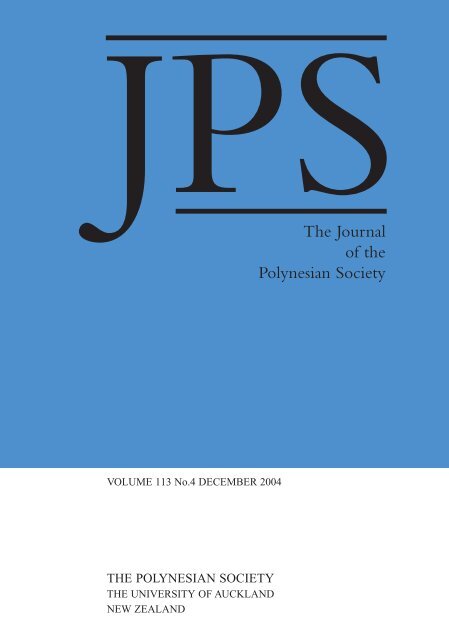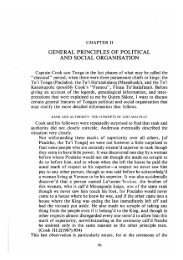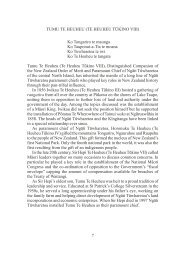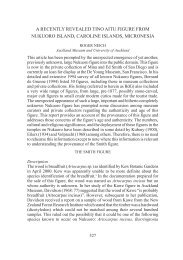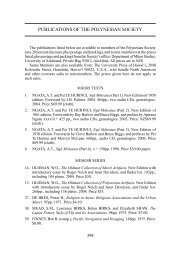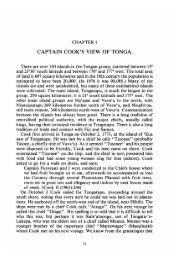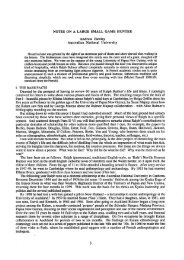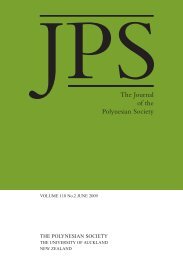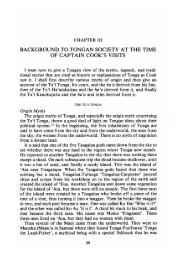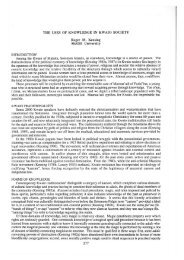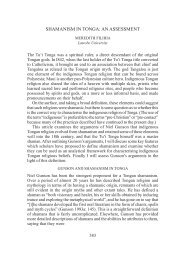The Journal of the Polynesian Society - The University of Auckland
The Journal of the Polynesian Society - The University of Auckland
The Journal of the Polynesian Society - The University of Auckland
You also want an ePaper? Increase the reach of your titles
YUMPU automatically turns print PDFs into web optimized ePapers that Google loves.
<strong>The</strong> <strong>Journal</strong><br />
<strong>of</strong> <strong>the</strong><br />
<strong>Polynesian</strong> <strong>Society</strong><br />
VOLUME 113 No.4 DECEMBER 2004<br />
THE POLYNESIAN SOCIETY<br />
THE UNIVERSITY OF AUCKLAND<br />
NEW ZEALAND
<strong>the</strong> journal <strong>of</strong> <strong>the</strong><br />
polynesian society<br />
Volume 113 DECEMBER 2004 Number 4<br />
Editor<br />
JUDITH HUNTSMAN<br />
Review Editor<br />
MARK BUSSE<br />
Editorial Assistants<br />
CLAUDIA GROSS<br />
DOROTHY BROWN<br />
Published quarterly<br />
by <strong>the</strong><br />
<strong>Polynesian</strong> <strong>Society</strong> (Inc.), <strong>Auckland</strong>, New Zealand
Published in New Zealand by <strong>the</strong> <strong>Polynesian</strong> <strong>Society</strong> (Inc.)<br />
Copyright © 2004 by <strong>the</strong> <strong>Polynesian</strong> <strong>Society</strong> (Inc.)<br />
Apart from any fair dealing for <strong>the</strong> purposes <strong>of</strong> private study,<br />
research, criticism, or review, as permitted under <strong>the</strong><br />
Copyright Act, no part <strong>of</strong> this publication may be reproduced<br />
by any process without written permission.<br />
Inquiries should be made to:<br />
ISSN 0032-4000<br />
Hon. Secretary<br />
<strong>The</strong> <strong>Polynesian</strong> <strong>Society</strong><br />
c/- Mäori Studies<br />
<strong>The</strong> <strong>University</strong> <strong>of</strong> <strong>Auckland</strong><br />
Private Bag 92019, <strong>Auckland</strong><br />
Indexed in CURRENT CONTENTS, Behavioural, Social<br />
and Managerial Sciences, in INDEX TO NEW ZEALAND<br />
PERIODICALS, and in ANTHROPOLOGICAL INDEX.<br />
AUCKLAND, NEW ZEALAND
Volume 113 DECEMBER 2004 Number 4<br />
CONTENTS<br />
Notes and News ..................................................................................... 323<br />
Adrienne Kaeppler<br />
Appreciation and Challenge: Remarks at <strong>the</strong> Launch <strong>of</strong> <strong>the</strong><br />
Oldman Catalogues, 3 November 2004 ......................................... 325<br />
Articles<br />
FREDERIC PEARL<br />
<strong>The</strong> Chronology <strong>of</strong> Mountain Settlements in Tutuila, American Samoa ..... 331<br />
EMILY DONALDSON<br />
Vanishing Artefacts <strong>of</strong> <strong>the</strong> South Seas .................................................... 349<br />
Shorter Communications<br />
JIM SPECHT<br />
Lapita, <strong>The</strong> Solomons and Similarity Measures ................................................ 369<br />
JEAN GUIART<br />
Retoka Revisited and Roymata Revised: A Retort ............................................. 377<br />
Reviews<br />
Campbell, I.C.: Worlds Apart: A History <strong>of</strong> <strong>the</strong> Pacific Islands.<br />
DAMON SALESA ..................................................................................... 383<br />
Draper, Norm and Sheila Draper: Dictionary <strong>of</strong> Kyaka Enga, Papua<br />
New Guinea. WILLIAM A. FOLEY ........................................................... 385
Herdt, Gilbert: Secrecy and Cultural Reality: Utopian Ideologies <strong>of</strong> <strong>the</strong><br />
New Guinea Men’s House. THOMAS STRONG ...................................... 387<br />
Marshall, Mac: Namoluk Beyond <strong>the</strong> Reef: <strong>The</strong> Transformation <strong>of</strong> a<br />
Micronesian Community. JENNY BRYANT-TOKALAU .......................... 389<br />
Publications Received ....................................................................................... 393<br />
Publications <strong>of</strong> <strong>the</strong> <strong>Polynesian</strong> <strong>Society</strong> .............................................................. 395
NOTES AND NEWS<br />
Contributors to This Issue<br />
Emily Donaldson spent <strong>the</strong> last year and a half working as a contract archaeologist<br />
for <strong>the</strong> Navy in Pearl Harbor, Hawai‘i. This was only <strong>the</strong> last <strong>of</strong> several extended visits<br />
to Polynesia over <strong>the</strong> past four years. Having spent most <strong>of</strong> her life in New England,<br />
she enjoyed <strong>the</strong> change <strong>of</strong> scene. She has a Bachelor <strong>of</strong> Arts in Anthropology, and<br />
graduated Magna cum laude from Harvard College in 2003 with a Foreign Language<br />
Citation in French. Currently she is applying to graduate school in Anthropology and<br />
anticipates beginning her Ph.D. studies in <strong>the</strong> Fall <strong>of</strong> 2005.<br />
Jean Guiart, now retired from <strong>the</strong> Musée de l’Homme, is well-known for his<br />
work with various populations <strong>of</strong> Vanuatu and New Caledonia. He has published<br />
extensively on land tenure, myth and social structure, ethnohistory and art. In recent<br />
years, Pr<strong>of</strong>essor Guiart has devote his time and attention to producing a series <strong>of</strong><br />
shorter, more accessible, books about New Caledonia, intended as essays on issues<br />
crucial to that place and designed to provoke wider discussion.<br />
Adrienne L. Kaeppler is Curator <strong>of</strong> Oceanic Ethnology at <strong>the</strong> National Museum<br />
<strong>of</strong> Natural History, at <strong>the</strong> Smithsonian Institution, Washington D. C. Her B.A, M.A.<br />
and Ph.D. degrees are all from <strong>the</strong> <strong>University</strong> <strong>of</strong> Hawai‘i. Her research focuses on <strong>the</strong><br />
interrelationships between social structure and <strong>the</strong> arts, especially dance, music and <strong>the</strong><br />
visual arts. She is also a specialist on <strong>the</strong> artefacts collected and <strong>the</strong>ir documentation<br />
during <strong>the</strong> voyages <strong>of</strong> Captain Cook, <strong>the</strong> U.S. Exploring Expedition and o<strong>the</strong>r early<br />
voyages. Her recent publication, “Sculptures <strong>of</strong> barkcloth and wood from Rapa Nui:<br />
Symbolic continuities and <strong>Polynesian</strong> affinities” (RES, 44: 10-69), combines her<br />
interest in art, aes<strong>the</strong>tics, social structure and documentation.<br />
Frederic Pearl is <strong>the</strong> Director <strong>of</strong> <strong>the</strong> Maritime Studies Program at Texas A&M<br />
<strong>University</strong> in Galveston. He is jointly appointed to <strong>the</strong> Departments <strong>of</strong> General<br />
Academics and Marine Sciences, and has graduate affiliations with <strong>the</strong> Department<br />
<strong>of</strong> Marine Sciences in Galveston and <strong>the</strong> Department <strong>of</strong> Anthropology, Texas A&M<br />
<strong>University</strong> in College Station. He received his B.A. from San Diego State <strong>University</strong>,<br />
and his M.A. and Ph.D. from Texas A&M <strong>University</strong>. His current field projects are<br />
in <strong>the</strong> Samoan archipelago.<br />
Jim Specht retired from <strong>the</strong> Australian Museum, Sydney in 2000 after nearly 30<br />
years service, and is currently a Research Fellow <strong>of</strong> <strong>the</strong> Museum, Honorary Associate<br />
at <strong>the</strong> <strong>University</strong> <strong>of</strong> Sydney and a member <strong>of</strong> <strong>the</strong> Centre for Archaeology at <strong>The</strong><br />
Australian National <strong>University</strong>. His main research interests are Pacific archaeology<br />
and <strong>the</strong> history <strong>of</strong> museum collections.<br />
<strong>The</strong> Skinner Fund for Physical Anthropology, Archaeology and Ethnology<br />
Applications for grants from <strong>the</strong> above fund, sponsored jointly by <strong>the</strong> Royal<br />
<strong>Society</strong> <strong>of</strong> New Zealand, <strong>the</strong> <strong>Polynesian</strong> <strong>Society</strong> and <strong>the</strong> New Zealand Archaeological<br />
Association, close on 1 April 2005.<br />
323
324<br />
Notes & News<br />
<strong>the</strong> purpose <strong>of</strong> <strong>the</strong> fund is to promote <strong>the</strong> study <strong>of</strong> <strong>the</strong> history, art, culture, physical<br />
and social anthropology <strong>of</strong> <strong>the</strong> Mäori and o<strong>the</strong>r polynesian peoples, particularly<br />
through <strong>the</strong> recording, survey, excavation and scientific study <strong>of</strong> prehistoric and<br />
historic sites in new Zealand and <strong>the</strong> islands <strong>of</strong> <strong>the</strong> southwest pacific. this includes<br />
<strong>the</strong> detailed analysis <strong>of</strong> all cultural, artistic or physical remains which have been<br />
recovered as <strong>the</strong> result <strong>of</strong> such investigations. to this end both research projects<br />
having survey, recording and excavation as <strong>the</strong>ir goal, as well as those which propose<br />
to treat analytically and comparatively materials already so recovered shall be deemed<br />
to have equal weight. preference will be given to well-documented research plans<br />
which specify methodology and anticipated outcomes <strong>of</strong> <strong>the</strong> proposed research.<br />
<strong>the</strong> amount available for distribution from <strong>the</strong> fund is not large and, grants <strong>of</strong><br />
about $1,000 will be allocated.<br />
every recipient <strong>of</strong> a grant from <strong>the</strong> fund shall report to <strong>the</strong> royal society <strong>of</strong> new<br />
Zealand before 30 june in <strong>the</strong> year after <strong>the</strong> grant was made, showing in a general<br />
way <strong>the</strong> expenditure <strong>of</strong> <strong>the</strong> grant and <strong>the</strong> progress made with <strong>the</strong> research.<br />
<strong>the</strong> results <strong>of</strong> research aided by grants from <strong>the</strong> fund, shall, where possible, be<br />
published in new Zealand, with due acknowledgement <strong>of</strong> <strong>the</strong> source <strong>of</strong> financial<br />
assistance, and one copy <strong>of</strong> any report stemming from such research shall be sent<br />
to <strong>the</strong> society.<br />
applicants must provide a current curriculum vitae, an outline <strong>of</strong> <strong>the</strong> proposed<br />
research and a budget. applications should be sent to:<br />
<strong>the</strong> executive <strong>of</strong>ficer—awards<br />
royal society <strong>of</strong> new Zealand<br />
p o Box 598<br />
WellinGton<br />
all applications will be acknowledged.<br />
New Editions <strong>of</strong> Oldman Catalogues now available<br />
enhanced new editions <strong>of</strong> <strong>the</strong> oldman catalogues <strong>of</strong> Mäori and polynesian artefacts<br />
originally published and reprinted many years ago are now available. not only have<br />
<strong>the</strong> plates and text been enhanced and reformatted—as well as edited to remove<br />
glaring errors and inconsistencies, but also roger neich and janet Davidson have<br />
written an introductory essay about W.o. oldman, his collection and how it came to<br />
be in new Zealand, and produced a list locating which new Zealand museum holds<br />
each item.<br />
<strong>the</strong> polynesian society has been able to price <strong>the</strong> volumes relatively inexpensively<br />
for sale in new Zealand thanks to a production grant from <strong>the</strong> pacific Development<br />
and conservation trust and a publishing subsidy from new Zealand lottery heritage.<br />
for details, see <strong>the</strong> society’s publication list at <strong>the</strong> end <strong>of</strong> this issue.<br />
<strong>the</strong> address given at <strong>the</strong> oldman catalogue launch by adrienne Kaeppler, curator<br />
<strong>of</strong> oceanic ethnology at <strong>the</strong> smithsonian’s national Museum <strong>of</strong> natural history, is<br />
reproduced herein.


